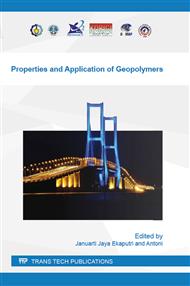[1]
Yang Z X, HA N R, JangMS, Hwang K H. 2009. Geopolymer concrete fabricated by waste concrete sludge with silica fume. Material Science Forum, 620-622, 791- 794.
DOI: 10.4028/www.scientific.net/msf.620-622.791
Google Scholar
[2]
Mahmoudkhani, A. H., Huynh, D., Sylvestre, C. J., & Schneider, J. (2008), New Environment-Friendly Cement Slurries With Enhanced Mechanical Properties.
DOI: 10.2118/115004-ms
Google Scholar
[3]
Davidovits (1994), Properties of Geopolymer cement.
Google Scholar
[4]
J.G.S. Van Jaarsveld, J.S.J. Van Deventer and L. Lorenzen (1997)., The potential use of geopolymeric materials to immobilise toxic metals: Part I. Theory and applications.
DOI: 10.1016/s0892-6875(97)00046-0
Google Scholar
[5]
Mohamed C M. Nasvi, Ranjith, P., &Sanjayan, J. (2012)., Mechanical Properties of Geopolymer Cement in Brine Its Suitability as Well Cement for Geological Sequestration of Carbon Dioxide (CO2).
DOI: 10.1016/j.apenergy.2013.05.050
Google Scholar
[6]
Mahmoud Khalifeh, ArildSaasen, TorbjornVralstad, Helge Hodne, 2014., Potential utilization of class C fly ash-based geopolymer in oil well.
DOI: 10.1016/j.cemconcomp.2014.06.014
Google Scholar
[7]
Cockrell C.F. & Leonard J.W. (1970): Characterization and utilization studies of limestone modified fly ash. Coal Research Bureau, Vol. 60.
Google Scholar
[8]
Dam, T. J. (2010). Geopolymer Concrete. Washington DC: US Department of Transportation.
Google Scholar
[9]
Seabrook P., K. C. (2003). Sustainability in Construction.
Google Scholar
[10]
Fly Ash as a Cement Replacement. Richmond: Levelton Engineering Ltd. Problem statement.
Google Scholar
[11]
Mustafa Al Bakri A. M., Kamarudin H., Bnhussain M., Khairul Nizar I. and Mastura W.I.W. (2010)., Mechanism and Chemical Reaction of Fly Ash Geopolymer Cement- A Review.
DOI: 10.4028/www.scientific.net/amr.626.937
Google Scholar
[12]
Daniel L.Y. Kong, Jay G. Sanjayan, 2007, Comparative performance of geopolymers made with metakaolin and fly ash after exposure to elevated temperatures.
DOI: 10.1016/j.cemconres.2007.08.021
Google Scholar
[13]
Fareed Ahmed Memon, MuhdGadhil Nuruddin, Samuel Demie and Nasir Shafiq, 2011, Effect of Curing Conditions on Strength of Fly ash-based Self-Compacting Geopolymer Concrete.
DOI: 10.4028/www.scientific.net/amm.567.362
Google Scholar
[14]
Priya Rachel, K. Ganesh Babu, 2013, Durability Study of Low Calcium Flyash Based Geopolymer Concrete.
Google Scholar
[15]
Walla S.E., Rangan B. V. 2006. Low calcium fly ash based geopolymerconcrete: long term properties.
Google Scholar
[16]
Uehara, (2010), New concrete with low environmental load using the geopolymer method. Quarterly Report of RTRI; ISSN: 0033-9008; VOL. 51.
DOI: 10.2219/rtriqr.51.1
Google Scholar
[17]
BAadurS, Chaudhary R. 2008. Utilization of hazardous wastes and by-products as a green concrete material through s/s process: a review. Rev. Adv. Mater. Sci, 17, 42.
Google Scholar
[18]
M. Fadhil Nuruddin, Samuel Demie, M. Fareed Ahmed, and Nasir Shafiq, 2011, Effect of Superplasticizer and NaOH Molarity on Workability, Compressive Strength and Microstructure Properties of Self-Compacting Geopolymer Concrete. World Academy of Science, Engineering and Technology.
DOI: 10.1109/natpc.2011.6136362
Google Scholar
[19]
Abdullah, M., Kamarudin, H., BnHussain, M., Nizar, I. K., Rafiza, A., &Zarina, Y. (2011).
Google Scholar
[20]
Al-Bakari, A. M., Kareem, A., &Myint, S. (2012). Optimization of Alkaline Activator/Fly Ash Ratio on the Compressive Strength of Fly Ash-Based Geopolymer. Kangar: Universiti Malaysia Perlis (UniMAP).
DOI: 10.36868/ejmse.2020.05.03.133
Google Scholar
[21]
Dwight K. Smith (1987), Cementing. Society of Petroleum Engineers.
Google Scholar
[22]
Subhash V. Patankar, Yuwaraj M. Ghugal, and Sanjay S. Jamkar (2014), Effect of Concentration of Sodium Hydroxide and Degree of Heat Curing on Fly Ash-Based Geopolymer Mortar. Indian Journal of Materials Science.
DOI: 10.1155/2014/938789
Google Scholar
[23]
Mohammed Rabbani Nagral, TejasOstwal, Manojkumar V Chitawadagi. 2014. Effect of Curing Temperature and Curing Hours on the Properties of Geo-Polymer Concrete. International Journal of Computational Engineering Research (IJCER).
Google Scholar
[24]
Palomo, A., Grutzeck, M.W., Blanco, M.T. (1999) Alkali-activated fly ashes: A cement for the future, Cement and concrete research Vol. 29, pp.1323-1329.
DOI: 10.1016/s0008-8846(98)00243-9
Google Scholar
[25]
Joshi, S., &Kadu, M. (2012). Role of Alkaline Activator in Development of Eco-friendly Fly Ash Based Geopolymer Concrete. International Journal of Environmental Science and Development, 417-421.
DOI: 10.7763/ijesd.2012.v3.258
Google Scholar


